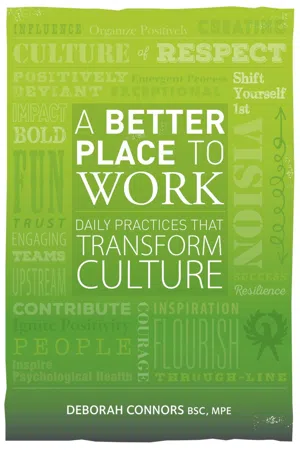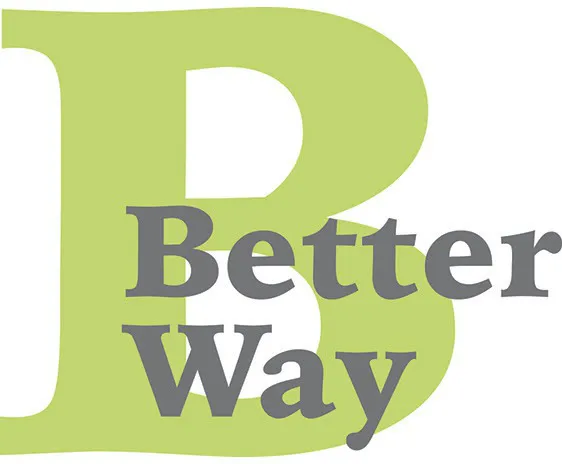
This is a test
- English
- ePUB (mobile friendly)
- Available on iOS & Android
eBook - ePub
Book details
Book preview
Table of contents
Citations
About This Book
In many organizations the culture is one of crises and overload, and work is about surviving versus thriving. The human and financial costs of negative work cultures are huge, but there is hope. This book is a practical guide full of stories of transformative workplace change. It is a synthesis of advice from business and organizational health experts which provides over 50 daily practices that support creativity, innovation and proactivity at work. It will inspire you to become positively deviant and overcome workplace negativity to create a culture of possibility where productivity soars and people flourish.
Frequently asked questions
At the moment all of our mobile-responsive ePub books are available to download via the app. Most of our PDFs are also available to download and we're working on making the final remaining ones downloadable now. Learn more here.
Both plans give you full access to the library and all of Perlego’s features. The only differences are the price and subscription period: With the annual plan you’ll save around 30% compared to 12 months on the monthly plan.
We are an online textbook subscription service, where you can get access to an entire online library for less than the price of a single book per month. With over 1 million books across 1000+ topics, we’ve got you covered! Learn more here.
Look out for the read-aloud symbol on your next book to see if you can listen to it. The read-aloud tool reads text aloud for you, highlighting the text as it is being read. You can pause it, speed it up and slow it down. Learn more here.
Yes, you can access A Better Place To Work by Deborah Connors in PDF and/or ePUB format, as well as other popular books in Business & Workplace Culture. We have over one million books available in our catalogue for you to explore.
Information
CHAPTER 1

“The bad times won’t last forever, but the story of how you stood up to them will. It’s time to write that story.”
—Stan Slap, Keynote Speaker, Conference 2010
I’m sitting in the chair at a new hair studio and, making conversation, the stylist asks me what I do. When I tell him that I teach leaders how to radically shift culture so that people can flourish, he says, “Oh, do we ever need that here!” It’s a familiar theme, whether I’m at the dentist, the accountant or talking to someone at a networking event. Invariably, when the topic of creating a better place to work comes up, people have a lot to say. It usually goes something like, “Business is great, but…” and then they go on to say something negative about the social environment at work. It’s often related to feeling overwhelmed or undervalued.
Why does this topic come up repeatedly? I think it is because as these businesses or departments grow and change, nine times out of ten, there is a focus on the core business, the products, the sales and marketing strategies and even on the customer experience, but no thought is given to the people doing the work.
A person’s performance at work is largely tied to whether they feel supported and appreciated by their organization. Hal Rosenbluth said it best in his book “The Customer Comes Second”: “Only when people know what it feels like to be first in someone else’s eyes can they sincerely share that feeling with others.”1
Yet I have seen many small businesses make the mistake of doing whatever it takes to please the client, at the expense of their own staff. Many departments within big organizations implement technical changes without having a strategy to help their people manage the effects of those changes on their mental and emotional health. People are then left feeling overwhelmed, stressed, burned out, and less able to be creative and to contribute their best work.
In preparation for this book I gathered information on healthy workplace culture, reviewing research from the thought-leaders I brought together over the 17-year period of leading The Better Workplace Conference, formerly called the Health Work & Wellness™ Conference. Because of the change in names, I will be referring to this event simply as “the Conference” for the remainder of the book.
I conducted in-depth interviews with ten particularly inspiring experts: Dr. Robert Quinn, Dr. Martin Shain, Dr. Michael West, Dr. Linda Duxbury, Marie Mac Donald, Dr. Graham Lowe, Melissa Barton, Mary-Lou MacDonald, Dr. Gregor Breucker, and Mary Ann Baynton.
This compilation of expert advice leads us to one conclusion: if we change our culture, we change our outcomes. Although programs, strategies and policies support conditions where people can flourish and succeed, it is the culture (or “how we do things around here”) that creates those conditions. Flourishing people contribute their best, see more possibilities, and are more proactive and innovative. If your change effort does not address the culture, success in achieving organizational health will be minimal.
The late Robert F. Allen describes culture (which he calls the “organizational unconscious”), as being “those patterns of social behaviour and normative expectations that become characteristic of an organization’s functioning, without its members consciously choosing them.” He describes how unconscious activity can block our conscious goals, so the first step in shifting those unconscious behaviours is recognizing them.2
Once we know that these behaviours and norms exist, they can be consciously improved. This positive improvement to the culture happens through the practices or behaviors we partake in daily. To “practice” means to engage in an activity repeatedly in order to improve it. For example, as we practice active listening, over time we become better listeners and can pick up on more verbal and non-verbal cues.
A practice is something that is never “mastered.” For example, as I practice examining my hypocrisies as a leader, I may get better at leading by example. However, will I get to a point where there is no hypocrisy between what I do and what I say? Probably not; there are always opportunities for further improvement.
As you will see throughout this book, there is overwhelming evidence that we can increase positivity and resilience in people, teams and organizations through daily practices. These practices positively impact creativity, innovation, productivity, employee satisfaction, customer service, customer satisfaction and the financial outcomes of the organization.
All too often though, efforts to improve organizational health focus only on implementing a program. This might be a stress management program or a series of lunch and learn seminars. While the information in these programs may be useful, the focus is on individual health, not the health of the organization and—more specifically—not on changing the culture. In fact, the culture is often not even considered as the reason for the lack of organizational health or performance. The culture does not change with this approach, and research shows that most workplace health programs yield poor results in terms of their impact on organizational performance.
Here’s a mini practice for you: each time you see one of these questions in a box throughout the book, put the book down and think about how it would feel to ask this question in your workplace. There is a question posed in each chapter, like the one below, that I hope will be a transformational one for you—one that makes you think differently, take on a new challenge or create a new vision. It will be in a green, abstract box somewhere in the chapter. When you come across each one, stop and reflect on it and perhaps make a few notes for yourself.

If you look ahead six months, what differences would you like to see in your workplace? What about one year from now? Three years from now?
The goal of this book is to help you achieve this vision. It will encourage you to shift your culture in an upward direction by developing practices that increase your positivity and resilience and help you to become a more transformational leader. Doing this work will greatly increase your chance of creating a culture where people can contribute their best.
Slow Death
If we are doing nothing to move our organization in a positive direction, it will be spiraling towards what Dr. Robert Quinn calls “slow death.”
Quinn was the opening keynote speaker at the Conference in 2012. He is author of several outstanding books on leadership and positive workplaces.3,4 He is also one of the thought-leaders I interviewed for this book.
In his decades of studying organizations, he has observed that they are always in the state of becoming more positive or becoming more negative; they are never stagnant. The “normal” state is to grow, and then to plateau. At this point, things become routine and people tend to get comfortable and, often, complacent. The problem is that the world outside the organization is not stagnant, and so what may feel like maintenance is the start of a downward spiral leading to slow death.
You may have experienced this circumstance at some point; I personally encountered it when working in a large organization where the culture seemed to get more and more negative. People were burning out, but no one seemed to know how to stop the decline. This is a common phenomenon, and is sometimes the result of not wanting to—or not knowing how to—make the deep changes needed to turn things around.
Quinn says that most people choose slow death over making deep change. Why? Because shifting the culture requires significant personal change, and this often seems daunting.
There is no step-by-step, cookie-cutter approach to this challenge. Quinn describes North American organizations as having a “checklist mentality,” meaning we want an easy path (or checklist) to follow. It often looks like this: an expert comes up with a strategy that works in one organization, which then becomes a “best practice” which others copy. It is a fast and easy process, but one that doesn’t often work because every workplace culture will respond differently to a set approach.
To illustrate this checklist mentality, Quinn talks about the great success that Toyota had years ago with their Lean Program.5 Lean is a method of maximizing customer value while minimizing costs. Thousands of companies have tried to replicate what Toyota achieved, but only a few have been successful. Quinn believes this is because the best implementation of the model is about changing the way people think and act at work rather than simply copying an existing strategy verbatim.
When it comes to organizational health and wellness, most companies take the same approach. A high percentage of large organizations will report having a wellness program which may include fitness, mental health, disease management or any number of health initiatives. In most cases, this program does not address the workplace culture.
In my interview with Dr. Quinn, he said, “Many administrators don’t even see the culture, or understand it, much less imagine changing it. Most don’t see culture as their business.”
Many senior executives see managing the culture as someone else’s job.
Maybe you’re the “someone else.”
The Cost of Doing Nothing
Culture is not always seen as being important to business goals. However, there is a “cost to doing nothing.” This is a phrase often used by Dr. Martin Shain, ...
Table of contents
- Cover
- Title Page
- Copyright Page
- Dedication
- Gratitude
- Contents
- Definitions
- Introduction
- Chapter 1: Better Way
- Chapter 2: Engage in Practices
- Chapter 3: Positively Deviant
- Chapter 4: Organize Positively
- Chapter 5: Shift Yourself 1st
- Chapter 6: Ignite Positivity
- Chapter 7: Teams
- Chapter 8: Inspire Psychological Health
- Chapter 9: Vision
- Chapter 10: Emergent Process
- Chapter 11: Best Advice & Tools
- Resources
- References
- About the Author